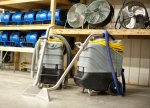Preventing Basement Water Damage
 Flooding often occurs as the result of a heavy storm or hurricane or from rising bodies of water. It can also occur from leaks inside the house or due to freezing pipes in the winter. However water gets into a basement, it can seep into the insulation, studs or carpet. This dampness can lead to structural damage and mold contamination. Even a small amount of water can cause considerable damage that may cost thousands of dollars to fix.
Flooding often occurs as the result of a heavy storm or hurricane or from rising bodies of water. It can also occur from leaks inside the house or due to freezing pipes in the winter. However water gets into a basement, it can seep into the insulation, studs or carpet. This dampness can lead to structural damage and mold contamination. Even a small amount of water can cause considerable damage that may cost thousands of dollars to fix.
Preventative measures are the best way to keep your basement water-free. They will help keep the most common basement flooding problems from occurring.
Many basements have cracks in the walls that allow water and moisture to enter. Waterproof coating on the basement walls will keep water from passing through because of hydrostatic pressure. (Pressure caused by water in the soil.) The cracks should be filled and the waterproof coating should be applied as directed, with even a second coat recommended.
Any other leaks should be fixed, including any interior pipe leaks. Even a slow pipe leak can cause considerable water damage over time. Drainage from the basement should work properly, and if necessary, a sump pump should be installed. Choose a sump pump that best meets your requirements and check it often to make sure that it’s properly working.
Your gutters should properly drain the water away from your home’s foundation. Water should not be diverted as far away as possible and not allowed to collect near the home.
If your home does become flooded, seek professional help to remove the water and properly dry the area out. After water evaporates, it remains in the area as moisture. A high degree of moisture can feed mold growth, which can cause more damage and expense to fix.
Basement flooded? H&H Environmental Construction and Consulting water cleanup crews will respond within 30 minutes. We service New York, New Jersey, Connecticut, Massachusetts, Westchester and New York City.
Water damage due to storms and flooding do more than structural damage. The aftereffects can be just as damaging as Read more
As the number of foreclosed REO (Real Estate Owned) properties rises, the link between foreclosure and mold keeps growing.
With the right environment, mold and black mold can grow almost anywhere. The most obvious places are on walls, ceilings, Read more
Home inspectors are generally not liable to discover defects that are concealed from view. Also, mold may not within the Read more
